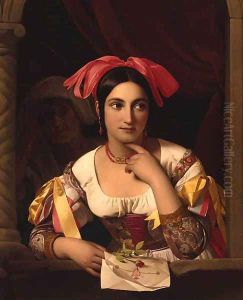Jan Baptist Lodewijk Maes Paintings
Jan Baptist Lodewijk Maes, also known as Lodewijk Maes, was a Belgian artist born in 1794 in Mechelen, a city in the Flemish region of Belgium. He was primarily known for his work as a painter and engraver. His period of activity falls into the 19th century, a time when European art was transitioning through various movements, including Neoclassicism, Romanticism, and the early stages of Realism. Despite the lack of extensive records on Maes's life, his contributions to Belgian art in the 19th century are appreciated by art historians and collectors alike.
Maes's artistic journey began in his hometown of Mechelen, where he was likely exposed to the rich artistic traditions of the Flemish region. The Flemish areas of Belgium have a long-standing reputation for producing skilled artists, a tradition that stretches back to the Renaissance with figures like Peter Paul Rubens. Although Maes did not achieve the same level of fame as Rubens, his work reflects the technical proficiency and attention to detail that Flemish artists are known for. His style was influenced by the prevailing artistic movements of his time, yet he managed to carve out a niche for himself with his unique interpretations and techniques.
Throughout his career, Maes focused on both painting and engraving, showcasing his versatility as an artist. His engravings are particularly noted for their precision and detail, capturing the essence of his subjects with clarity and depth. These works contributed to the visual culture of the 19th century in Belgium, providing insights into the aesthetics and sensibilities of the period. Unfortunately, specific details about his most famous works and exhibitions remain scarce, as records from that era did not always thoroughly document the achievements of artists who were not at the forefront of the European art scene.
Maes's contributions to Belgian art were recognized locally during his lifetime, but his fame did not extend far beyond his regional context. Today, his works are appreciated by art historians and collectors who specialize in 19th-century European art, especially those with a focus on the Flemish tradition. His paintings and engravings offer a window into the artistic trends and cultural atmosphere of Belgium during a time of significant change and development.
Jan Baptist Lodewijk Maes passed away in 1856, leaving behind a legacy that, while not widely recognized internationally, remains an important part of Belgium's artistic heritage. His dedication to his craft and his ability to navigate the artistic movements of his time contribute to our understanding of 19th-century European art. As more research is conducted, the hope is that Maes's work will gain greater recognition and appreciation, highlighting his role in the rich tapestry of art history.
